Advancements in technology have led to the rise of various ride-sharing applications that have revolutionized the way we travel. These mobile platforms offer an alternative transportation method for commuters by connecting them with drivers through user-friendly interfaces. The development of such applications has significantly impacted the transportation industry, and this article aims to explore how they came into being, their merits as well as potential future enhancements.
What is Ride Sharing?
A ride-sharing, an alternative form of transportation, is a collection of people traveling in the same direction and occupying the same car at some point during their journey. It is also an environment-friendly and cost-viable means of travel and at the same it can be used to ferry more than one person, making them cut down their travel expenses. Ride-sharing is run or operated through an app that allows drivers and travelers who need to share rides. This not only gains people by saving money and reducing their Carbon footprint but also mitigates the traffic pressure, strengthening the sense of community among passengers. In conclusion, ride-sharing is a convenient and eco-friendly way of traveling that can turn out more profitable than conventional modes of transport.
How to Start an On-Demand Car Pooling Business?
Starting an on-demand carpooling business through an app offers several advantages. It can reduce traffic congestion, lower individual transportation costs, and contribute to a more sustainable environment by optimizing the use of existing resources.
According to Statista, the Shared Ride market is anticipated to achieve a revenue of US $448.90bn in 2024, with a projected compound annual growth rate (CAGR 2024-2028) of 4.20%. This growth is expected to lead to a market volume of US$529.10bn by 2028. If you’re planning about developing a ride-sharing app, this is the best time to do so.
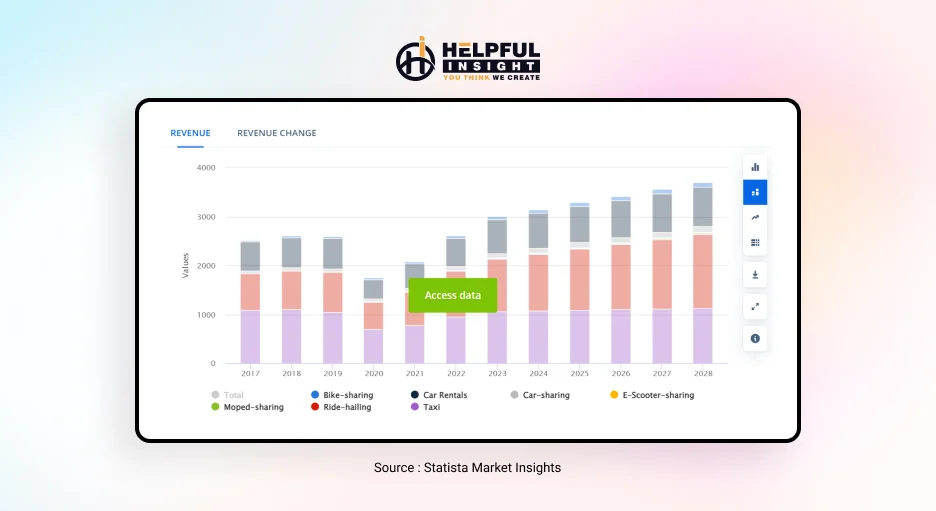
In this space, we’ll discuss every aspect of developing car ride-share apps, from the current market situation to finding the right car ride-sharing app development company in NYC.
1. Research the market:
Before beginning any enterprise, one needs to carry out proper research about the market. In doing so, it is necessary to understand the current trend in carpooling services and the intensity of competitors; determine whether consumer demand for the product exists; and analyze consumer needs and preferences.
2. Develop a business plan:
A good business plan plays an important role in tracking your goals, objectives, and strategies. This needs to be outlined when you want to develop on-demand carpooling. It ought to include budgetary initiatives, promotion plans, and operational designs.
3. Obtain necessary licenses and permits:
Different parts of the country may require you to obtain some licenses and permits as stipulated by the government to legally run a carpooling business. It may involve a business license, vehicle permits, and other forms of insurance.
4. Choose a suitable business model:
The types of business models that can be used in your vehicle carpool business include peer-to-peer or fleet, a company-owned. Compare the benefits and demerits of each one, and identify the appropriate system that aligns with your business purposes and target audience.
5. Develop a user-friendly app or website:
In this era of digitalization, operating an on-demand service business with a user-friendly app or website is fundamental. This will ensure that users do not spend a lot of time booking rides, tracking their progress, and even making payments. Therefore, this makes the system much easier to use for both drivers and passengers.
6. Build partnerships and network:
Partnerships with other business entities including hotels, airports, or events, enable your potential market to be increased and visibility as well. Besides that, cultivating drivers’ networks via referral or partnership will provide the required driver for your company.
7. Market your business:
Marketing your on-demand carpooling organization is essential in ensuring that you acquire several customers. Use social media platforms, paid advertising, and personal referrals to market your services to the audience you’re targeting.
8. Ensure safety and security measures:
Security should be one of the major priorities for a carpool business since you are dealing with both drivers and customers. These can be carried out by conducting a background check on the drivers, implementing safety measures, and offering insurance policies.
9. Set competitive pricing:
To draw and retain customers, it is crucial to establish competitive pricing rates for your carpooling services. Think about the operating costs, rivalry, and pricing on how they affect customer value when drawing your pricing strategy.
10. Continuously evaluate and improve:
Just like with any business you always want to keep an eye on how your On-Demand Car sharing services can be improved upon. Listen to input from customers and drivers because it is key in providing the requisite change one needs for a business to succeed.
What do Ride-Sharing Apps need to do to make money?
With the swirls of millions of users around the globe, speed is very important in any way possible from inputting various talents to just extracting revenue. This is quite well as innovativeness should not be limited to convenience but end up being a business which will realize profit.
1. Commission Fees: The Backbone of Revenue Generation
To generate income, the revenue is been charged through a percentage of each fare from drivers or by using a small service fee for riders, such cases have traditionally proven to be solid in building wealth. This alternative to the model allows your income to develop proportionally with the scaling of your platform.
2. Subscription Models: Unlocking Premium Benefits for Users
Create membership programs or subscription plans, in which features offered include the lower cost of riding for a customer, priority service, as well as participation in special offers. This enables an ongoing income through a superior service offering to the subscribers.
3. Advertising: Turning Rides into Ad Spaces
If you partner up with companies, turn your app into a money-making vehicle by allowing them to advertise on it. Advertise in the app, and allow advertisers to ‘pay’ for displaying their ads to a dedicated market within that platform, by paying for exposure while riding. It’s a mutual benefit, gaining user satisfaction and making a profit for your software company.
4. Premium Features: Catering to Diverse User Preferences
Boost the user experience with a premium option, for example, provisioning of luxury cars, instant matching, or even new exclusivity features. Offer these premium products for a fee, right from the personalization standpoint to those willing to spend just that little extra bit.
5. Data Monetization: Turning Insights into Revenue
Analyse and anonymize the user data to get valuable prevailing insight. Anonymous these insights and provide them to businesses or city planners, making sure the guard of regulations regarding privacy is intact. This approach can have the dual benefit of creating a new revenue avatar while contributing to more modern urban planning.
6. Develop a User-Friendly App
The first stage in generating profit from ride-share apps is creating an application that allows users to navigate a journey with ease and experience no hindrance. This will lead to more customers and this in the long run puts money into one’s coffers.
7. Set Competitive Prices
To make your customers want to use the ready-sharing services, you need to set competitive prices as much as possible. Carry out market research so that you are aware of the prices other ride-sharing platforms are quoting and try to price mean or slightly lower than your competitors.
8. Offer Incentives
To increase customer base and retain old customers, inculcate unique incentives in the business. You may offer discounts, referral bonuses, or loyalty programs. By doing that you will not only attract more customers but also create a habit of consuming your product among the ones who already have become your loyal clients.
9. Partner with Businesses:
By working with companies such as hotels, restaurants, or event venues you will attract new customers and so raise your turnover. You can give additional offers or package deals for customers who use your ride-sharing application to visit such partnered companies.
10. Utilize Advertising
Getting the word out about your ride-sharing app takes a lot more than creating a convenient web page, phone number, and email address. Social media marketing can help you reach many new people. Alternatively, you can also implement paid ads to concentrate on audience groups within socioeconomic aspects for better brand recognition.
11. Expand to Other Cities
Setting up the market in one city is often a good start for a ride-sharing app; then it would be possible to gradually expand into other cities which may help you increase as many customers as you can have, and therefore, revenue. This will allow you to keep in the lead of rival firms that have only one city base of operations.
12. Offer Additional Services
Maybe it would be possible to add some of the additional services including food delivery or package delivery via your ride-sharing platform. What is more, fewer revenues will not only be collected but an appropriate customer base (wider in scope) will also be attracted.
13. Provide Excellent Customer Service
As a business property, not to mention the success of that company, effective customer relations are what counts when providing excellent service. Make sure you have a dedicated customer service team, which can be accessed immediately whenever there arises an issue or concern of any kind about service or operation. This will ensure that your image remains positive, by ensuring customers keep on coming back for more.
14. Monitor Expenses
Record the activities whereby you make money from the ride-sharing app and readjust those that make loss margins to realize profits. This could mean looking for ways of reducing costs or finding additional sources of income.
15. Continuously Improve and Innovate
Lastly, to stay on top of an already competitive ride-sharing marketplace, it has also become a necessity instead of the luxury that innovation is and more so for technical advancements. Do not forget to conduct feedback surveys from customers and accordingly carry out updates that would help in enhancing further their experience to attract another lot of bring them on board.
Advantages of Creating Ride Share Apps Using Scratch Building
- Customization: The ability to create a ride-sharing app from scratch is one of the greatest advantages because it allows the customizing of solutions to business needs and, in particular, potential target audiences. This enables the app to provide a custom experience, which in turn can establish it over its competitors.
- Flexibility: The task of building your custom mobile app from ground zero also ensures that developers can include new functionality and change certain elements based on changes in the marketplace. This concept is even more important when it comes to a market that tends to change with new trends and technologies that happen on a daily or almost every week, as compared to those user preferences.
- Control over Security: All the security features that developers incorporate into a custom-made app will only be within their control. This is vital since the crucial information that ride-sharing applications handle includes user financials such as credit card details and location data. Constructing everything from the ground allows for incorporating modern security protocols that are applied regularly to ensure the protection of user information.
- Cost-Effective: Although the practice itself appears to be illogical, it is beneficial in the long-term perspective. Personalization and customizing are factors that make the app more suitable for meeting business demands rather than unnecessary workstations with irrelevant features or costs attached to a predefined set of templates.
Develop a reliable, user-friendly ride-sharing app that meets today’s demands.
How Much Ride-Sharing App Development Cost?
The cost of developing a ride-sharing app can vary significantly based on several factors, including features, complexity, platform (iOS, Android, or both), design, and the development team’s hourly rates. The general breakdown is as follows:
1. App Development Team
The first and the oppressive cost of ride-sharing has been stipulated to be the development team. This is because retaining a set of qualified specialists, developers as well as designers and project managers, can be not the cheapest option; however, it is an important aspect for ensuring that a quality app or functional web portal. They will work on the design of an app with a clean user interface and back-end development, which are all necessary in a competitive ride-sharing market.
2. Features and Functionality
The app’s overall cost is also affected by its distinguishing properties and functionality. Basic functionalities, such as ride scheduling, real-time tracking, and integrating payment methods are critical elements in a successful solution for sharing rides. Similarly, if you want to be competitive and unique in the marketplace, then it’s a good idea to incorporate additional capabilities such as in-app chat, several forms of payments like cashless payment methods cabs meaning POS-based or card-swiping facilities, mobile wallets, and driver rating systems. The two factors, time and resources are directly related to each other; the higher value of one leads to a proportional increase in the other. Because the more features you include, the longer it would take for development- which just means that there is an associated rise in the corresponding cost.
3. Technology Platform
Besides, the type of technology platform that is chosen to be used by a ride-sharing app developer also influences what amount of money spent on developing ride-sharing applications. While comparing the prices of native apps dependent on iOS and Android, there will be variances free because they use diverse programming languages and growth apparatuses. Alternatively, hybrid apps can be implemented on both platforms at the same time increasing the swiftness and reducing total costs. On the flip side, native apps are known to facilitate a more efficient and superior user experience compared to web apps.
4. API Integrations
Ride-sharing apps rely on third-party services like mapping and payment gateways to function. These API integrations come with additional costs, as you will need to pay for the use of their services. The more integrations you require, the higher the cost will be.
5. Testing and Maintenance
A crucial aspect of app development is testing and maintenance. This ensures that the app functions smoothly and that any bugs or issues are fixed promptly. Testing and maintenance require ongoing efforts and resources, which should be factored into the overall development cost.
The development cost of a ride-sharing app can range from $50,000 to $200,000, depending on the above factors. It is essential to carefully consider your budget and requirements before embarking on the development process. It is also recommended to work with a reputable app development company that specializes in developing apps across various categories and can provide a detailed cost breakdown and guide you through the development process.
How to market your Ride Sharing App?
Ride-sharing apps have made traveling convenient and easy as carpooling has not only become popular but a common mode of transport. As the demand for transportation facilities that are simple and affordable continues to grow, these developers have a big market to target. Even though we are all targeting the same market audience, with increased competition in this industry, it is important to have a powerful marketing strategy that will help you stand out and attract even more users. Developing a plan for promoting a ride-share app is essential before its release. To assist you, we have provided some suggestions for promoting the application:
1. Identify your target audience:
One of the essential steps to take before starting marketing your application is defining a specific audience target. Who do you think would be most likely to use your sharing app? Which category of people are they? What are their thoughts and preferences? Find out what your target group wants and tune your marketing activities so that you are always directed to the right goals.
2. Create a strong brand image:
A strong brand name is an essential facet of the competitive market. Therefore, your company image should communicate the unique selling proposition of your application and core values that will be of interest to solving user needs. Spending to come up with a brand ensures that you capture the audience’s attraction, for instance in visual terms have an image logo, some simple but attractive slogan, and graphic design elements.
3. Leverage social media:
When it comes to all this, platforms such as Facebook, Instagram, and Twitter are effective advertising channels that you should utilize to market your car ride-sharing app. Design interesting content and post sponsored advertisements for an audience other than your social media community while working together with influencers. See the advantage of hashtags and location-based targeting to attract people with a potential interest in your market.
4. Offer incentives and referral programs:
It is through incentives and referral programs that a business will be able to draw in new users while at the same time imparting loyalty to those already using their goods. Feature the first-time users using coupon discounts and promo codes, but also encourage current users to make their friends use your app. This will not only work in bringing on new users but also for those seeking to have undying loyalty and active engagement by the loyal ones.
5. Collaborate with businesses and events:
The best thing that can ever occur is linking up with local businessmen, events, and organizations to promote your ride-sharing application. Book a location or event for your brand and offer attractive discounts to customers of the same company or attendants of such an event. This can contribute to brand marketing so that its visibility and credibility are enlarged.
6. Utilize traditional marketing methods:
Though digital marketing is a paramount component of business success, never underrate the importance of old-fashioned approaches. Provide print and electronic media-based promotion by advertising your app through newspapers and magazines, both the mass-market as well as niche publications; include radio and television commercials in these. Moreover, can also keep flyers and brochures at busy sites or at events to inform people about your business.
7. Focus on customer experience:
Word-of-mouth marketing is an extremely important tool – thus, prioritizing a positive customer experience matters in the success of your Uber-like application. Ensure that the app is intuitive, and as efficient as possible while pricing it lower than market alternatives to stand out. Enormity consumers to review and rate the show, for concern regarding reviews providing timely feedback.
Features of Ride-Sharing App for Riders
Ride-sharing apps have completely revolutionized the way people commute nowadays, offering unprecedented convenience, transparency, and efficiency both for riders and drivers. Here’s a list of features frequently found in these apps that enhance the rider’s experience:
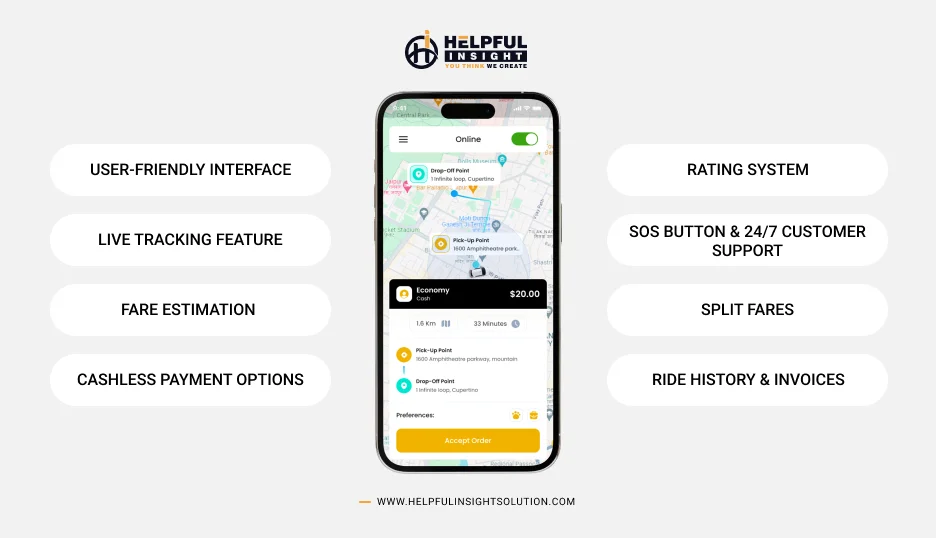
1) User-friendly Interface:
Ride-sharing apps typically sport an intuitive UI that allows even technologically challenged individuals to easily book rides.
2) Live Tracking Feature:
Real-time monitoring of your driver’s location strengthens trust and ensures peace of mind while you wait for pickup.
3) Fare Estimation:
Riders are usually provided with a fare estimate beforehand eliminating shocks at the end of the journey; some even offer surge-pricing alerts to increase transparency further.
4) Cashless Payment Options:
These applications often include integrated payment systems allowing users to pay seamlessly via their preferred method—credit card, debit card, or mobile wallets like Apple Pay—and eliminating cash exchanges making it hassle-free.
5) Rating System:
Riders get opportunities post-trip to rank their driver experience which acts as a quality check motivating healthy competition among drivers ensuring high-quality service along with continuous improvement from the providers’ side.
6) SOS Button & 24/7 Customer Support-
A strong safety feature equipped in most popular ride-hailing apps where if there is any concern during your trip you can intimate emergency services directly coupled with robust customer support available around the clock making passengers feel secure throughout their journey.
7) Split Fares –
One of those eye-catching features propelling app adoption among friend groups aiming at evenly dividing trip charges by sending separate invoices simplifies reimbursement procedures between friends/family members without playing monetary math games on manual splitting methods before parting ways after long drives together.
8) Ride History & Invoices –
Make tracking expenses systematic by having records accessible anytime empowering users to quickly retrieve past reservations/download travel bills when needed Those live-life-on-the-go individuals expect instant access for reimbursements corporate purposes personal finance management etc. meaning avoiding piles of paperwork since everything can be electronically stored and archived.
Features of Ride-Sharing App for Users
Ride-sharing apps have dramatically transformed the way we commute today. These apps serve as digital platforms offering numerous benefits to users seeking convenient, affordable, and hassle-free transportation solutions. Let’s explore some key features that make ride-sharing apps so popular among users:
1. User-Friendly Interface:
Ride-sharing apps possess interactive yet intuitive interfaces enhancing ease-of-use for even novices. With just a few taps, users can book rides swiftly without any hassle.
2. Real-Time Tracking:
A prominent feature of these applications is real-time tracking that enables users to follow their ride’s progress on an in-app map feature—ensuring complete transparency and peace of mind.
3. Time & Cost-Efficiency:
Car-sharing apps provide quicker travel alternatives compared to traditional public transport means—an advantageous factor for time-conscious individuals fighting against traffic congestion.
4. Automated Fares & Payment Options:
These technologies calculate fares based on distance traveled plus additional variables (if any), avoiding discrepancies commonly related to cash-based services Furthermore, cashless payment systems provided by such platforms create seamless transactions ensuring convenience throughout the user experience cycle.
5. Safety Measures & Monitoring Tools:
Safety always remains a paramount concern for riders – ride-sharing app developers acknowledge user concerns by integrating safety measures such as identity verification of drivers and mutually beneficial rating systems facilitating the creation of secure space for both drivers and riders ensuring a comfortable anticipated journey overall.
These are just examples highlighting features attracting people to these modern transport-centric services frequently seen in similar desired extended urban-rural areas worldwide.
Some of the Popular Ride Sharing Apps
Ride-sharing applications like Uber, Lyft, Grab, and Didi Chuxing have completely transformed the way people travel across cities. These tech-savvy platforms have revolutionized the transportation industry by connecting riders with drivers at the touch of a button. With their user-friendly interfaces and affordable pricing structures, these apps have garnered immense popularity worldwide.
Uber: Cab Booking Platforms
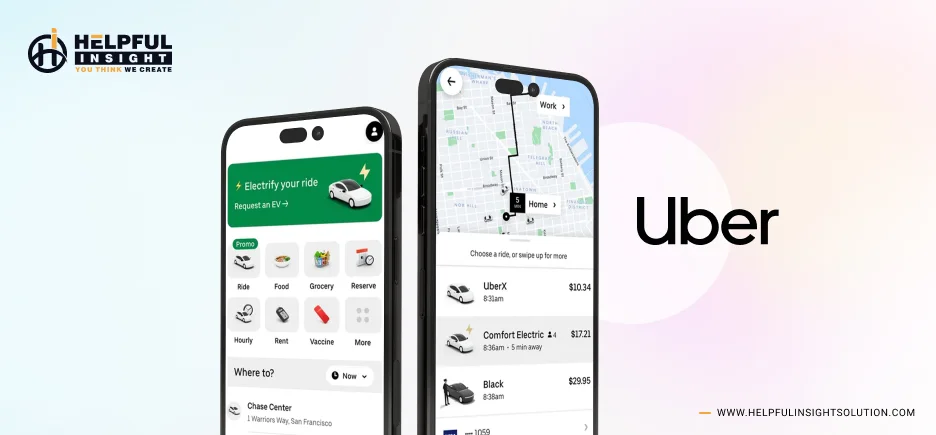
Uber, undoubtedly one of the pioneers in ride-sharing technology, has emerged as a global phenomenon since its launch in 2010. Available in more than 600 cities across six continents, Uber easily connects riders to local drivers through its intuitive mobile app interface. Moreover, Uber offers various service levels that cater to different needs ranging from basic hatchbacks to luxurious sedans.
Lyft: Most Affordable Rideshare App in USA
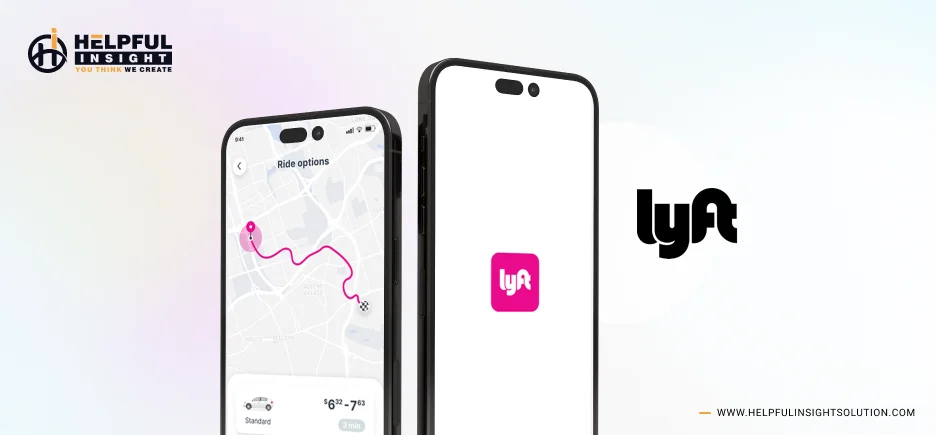
Lyft – another prominent player in this industry making waves primarily within North America and expanding internationally as well over time. Both Lyft and Uber follow similar operating procedures by providing affordable door-to-door transport along with added features such as shared rides (carpooling) or premium services for special occasions.
Grab: Grocery App in Southeast Asia
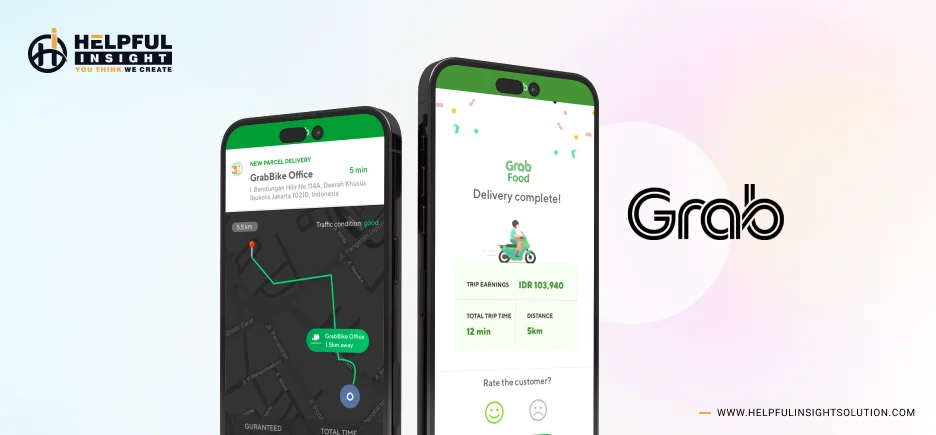
Grab – an app that originally started as a taxi-hailing platform before significant growth led it towards becoming a competitor of both Uber and Lyft regionally. With Grab’s diverse array of services spanning multiple countries including Indonesia, Singapore & Malaysia amongst others – users can conveniently choose from bikes (like Ojek), cars, or even more luxurious SUVs depending on personal preferences.
Didi Chuxing: Leading Mobile Transportation Platform
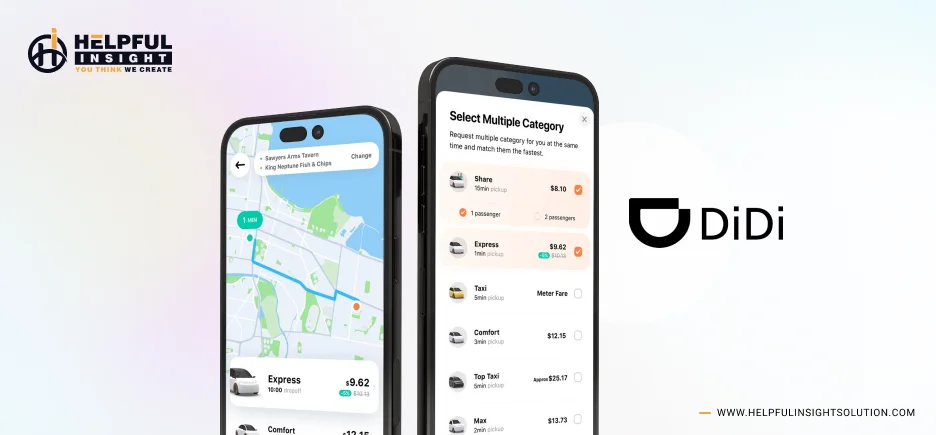
Didi Chuxing – It reigns supreme holding the largest market share amid tough competition from other homegrown players seeking their slice out east such as Meituan-Dianping’s Shouqi Car Rental Services etc., Didi caters not only within mainland China but also boasts partnerships abroad through alliances like Taxify which aids tourists to navigate unfamiliar territories seamlessly using a same familiar interface they’ve grown accustomed back home domestically!
Partner with us for innovative ride-sharing app development that stands out.
How to develop a ride-sharing app?
Developing a ride-sharing app involves several key steps. First, it’s crucial to define your goals and target audience. Identify the main purpose of your app—is it meant for everyday commuters or long-distance travelers? This information will help you shape the core features accordingly.
- Once you have a clear vision, conduct market research to understand other ride-sharing apps currently available. This will provide insights on their strengths and weaknesses, helping you differentiate your product successfully. Developing a unique selling proposition can be essential—stand out by incorporating innovative features or addressing unmet needs in the market.
- Next, outline the functionalities required for both passengers and drivers. Intuitive user interfaces and seamless navigation are crucial to ensure everyone can easily avail of services without hassles. Key features may include multiple payment options, vehicle tracking systems using GPS technology, or even incorporating voice recognition bookings.
- From there on designing wireframes/mockups of each screen along with flowcharts is essential before diving into actual development stages as this makes developing an app less complex by knowing how different screens interact with each other Also it is a great tool during UI / UX reviews & building prototypes showing potential investors what they could expect from final deliverable helping them get a better understanding about what kind of experience should be expected while using the app.
- The next stage requires coding expertise—hiring competent developers intimately familiar with programming languages such as Java, Swift (for iOS), Flutter or React Native amongst others becomes vital at this step making these specialists an asset since they will bring their ideas together amalgamating design elements into blueprint criteria from the previous stage.
- Lastly came quality assurance testing avoiding launching bugs-ridden software though time-consuming but guarantees to deliver stable products to end-users resulting in positive feedback carving a stronger reputation creating a loyal customer base boosting business growth.
Conclusion
In conclusion, ride-sharing applications have brought about a significant revolution in urban transportation and altered the way we travel. These platforms harness innovative technology to offer us the convenience of getting around easily within a city without owning a private vehicle. Their popularity lies in their ability to unite people with similar commutes or destinations.





